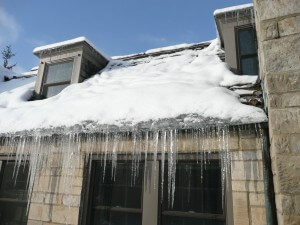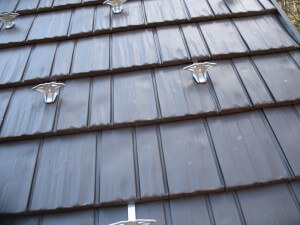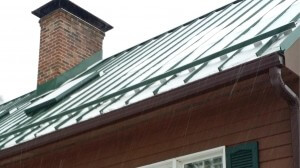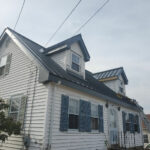Why Metal Roof Snow Brakes Should Be Thought About In the Spring and Summer
May 20, 2014 | By Mike Gonet | Filed under: Articles, Education, Metal Roofing, Technical
The flowers beginning to bloom are only one of the many beautiful manifestations of the calm, tranquil, and spring-defining month of May. As the summer is approaching, we are seeing warmer and sunnier afternoons. The metal roofing industry is beginning its yearly cycle and homeowners all over New England are simultaneously looking to get a new metal roof. It has been frequently said that getting a metal roof is essential for the lifetime protection for a safe, worry-free future of a home; so, with this level of ease in mind, let’s talk about a worrisome topic that may not be top of mind this time of year: snow!
Ice Dams Review
 Some of the most common roofing problems we hear from homeowners across New England are almost always concerning ice, snow, and ice dams. Sure, these conditions resulting from the many winter elements are troublesome at that given time; however, you should consider the long-term damage that ice and snow can typically do to roofing and how this damage can be prevented.
Some of the most common roofing problems we hear from homeowners across New England are almost always concerning ice, snow, and ice dams. Sure, these conditions resulting from the many winter elements are troublesome at that given time; however, you should consider the long-term damage that ice and snow can typically do to roofing and how this damage can be prevented.
Let us consider why your asphalt roofing had ice dam issues last winter. If there is poor ventilation in your roofing, heat from the house probably rose up into the attic and melted the snow that was over the given heated areas. Snow that had piled up over your unheated overhangs, such as your porch roof, did not have the same effect. When the ice on the higher parts of your roof began to melt from the heat, it probably began to seep down to the overhangs and freeze into ice. This ice could have backed its way into the roofing material and entered your structure. This is a notoriously endemic issue, and neglecting extra snow that is on your roof can cause serious internal damage of your home.
Pro-tip: If you are not investing in a metal roof, invest in a snow rake, at the very least.
Understand that any type of roofing can be susceptible to ice dams, especially when there is an environment of extremely freezing temperatures and no sun. It can happen on a metal roofing system when snow builds up from the ground or gutters and makes its way up onto the roofing system. This, however, usually is not an issue with a metal roofing system – just be cautious.
Underlayment / Roof Deck Protection
In case of any potential ice dam issues on a metal roof, find out what your hired contractor is planning on using for roof deck protection. An “underlayment” is a type of rubber membrane, such as Ice and Water Shield, which will provide additional protection to the roof deck, not the shingles. This will protect your home from any potential water infiltration.
When the question, “Will a metal roof avoid ice dams?” is asked, the answer is, for the most part: yes! It is very rare to see an ice dam on a metal roof. In fact, it is so nonexistent that, ironically, we actually need to utilize a method that will *prevent* the snow from falling off the roof too quickly. Metal roofing has a very smooth surface. Metal roofs also have high radiant heat reflectivity, meaning that when the sun’s rays strike the roof, they reflect outward. Radiant heat passes through the snow as soon as the sun comes out, spreading throughout the entire roof. The bottom of the snow starts to become slippery, causing it to slide off of the roof very easily and quickly. Subjectively speaking, a potential issue with a metal roof is not that the snow piles up; it is that it can come off too quickly! How is this prevented?
Metal Roof Snow Brake Systems: Known as Snow Guards, Snow Rails, or Snow Fences
*Classic Metal Roofs, LLC, unlike many other metal roofing contractors in New England, includes the cost of snow brakes in every quote.
Why is it important to utilize metal roof snow brakes?
 Large chunks of snow falling off of a metal roof at once could be dangerous due to a steep pitch over doorways or vital areas of landscaping. Understand that if the pitch is not very steep, too-frequent spacing of the snow brakes could prevent snow from sliding off to too much of an extent to where it is not shedding any snow at all. In this case, or any other troublesome circumstances, a heat tape can be used on the overhangs to melt the snow. However, understand that the gutters and downspouts must also be lined with the heat tape to ensure that the melted snow can leave the roof efficiently.
Large chunks of snow falling off of a metal roof at once could be dangerous due to a steep pitch over doorways or vital areas of landscaping. Understand that if the pitch is not very steep, too-frequent spacing of the snow brakes could prevent snow from sliding off to too much of an extent to where it is not shedding any snow at all. In this case, or any other troublesome circumstances, a heat tape can be used on the overhangs to melt the snow. However, understand that the gutters and downspouts must also be lined with the heat tape to ensure that the melted snow can leave the roof efficiently.
There are a variety of styles for metal roof snow brakes, most of which interface very well with most products offered. Be sure to discuss with your contractor which type of snow brake will function and interface with your product most efficiently. Metal roof snow brakes can come in steel, aluminum, copper, and polycarbonate. Keep in mind that the material of the snow brake must match the metal of the roof. Therefore, an aluminum metal roof would require aluminum snow brakes. However, a stainless steel snow brake system can be used with just about any type of metal roofing system because it is nonreactive.
 If you have done some research on a manufacturer’s website regarding snow brakes, here is an insider tip: the recommendations they give on spacing and placement are often angled towards generating more revenue. Based on Classic Metal Roofs’ experience, for most areas, placing the snow brakes from 12” to 18” apart is adequate. During installation, be sure that the crew is keeping snow brakes away from valleys where snow tends to collect as opposed to escape.
If you have done some research on a manufacturer’s website regarding snow brakes, here is an insider tip: the recommendations they give on spacing and placement are often angled towards generating more revenue. Based on Classic Metal Roofs’ experience, for most areas, placing the snow brakes from 12” to 18” apart is adequate. During installation, be sure that the crew is keeping snow brakes away from valleys where snow tends to collect as opposed to escape.
If a contractor neglected to install snow brakes on your already-installed metal roof, there is still hope. Though aluminum snow brakes are installed structurally due to how durable they must be to withstand heavy chunks of ice and snow, a polycarbonate snow brake can be implemented after installation of the roof in case of any possible mistake. Polycarbonate snow brakes have special adhesives which stick them to the roofing material as opposed to being fastened into the roof. The reasoning for using polycarbonate snow brakes is, because they can be done in a retrofit, this can help avoid the potential of nullifying the factory warranty of the roof. Remember, putting a fastener through a panel will typically void your metal roofing system’s warranty.
Conclusion
Pay attention to what your prospective metal roofing contractor is planning on doing and whether or not that contractor meets your criteria. Add to your written criteria the utilization of snow guards and underlayment and be absolutely sure that the contractor you’re meeting with discusses these details with you.
For more information, check out how to select a metal roofing contractor …





